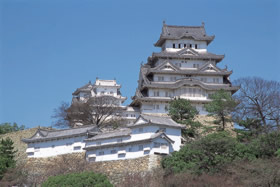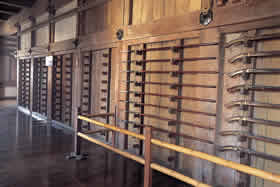Castle builders generally constructed the main tower at the highest place within the castle grounds. The tower rose high above the castle and offered a good lookout to check for enemy movement in the area. It also symbolized the power of the castle lord.
The area around the main tower was the most important part of the castle, and was called thehonmaru(main enclosure). Other compounds, such as theninomaruandsannomaru, were often arranged in a kind of spiral around the main enclosure. At Himeji Castle, the main enclosure was where political decisions were made. The lord of the castle, together with his family and relatives, had residences in theninomaru,sannomaruandnishinomaru(secondary, tertiary and western enclosures, respectively), and the castle grounds have not changed from that time.
A castle's most important function was to ward off enemy attack. Around Himeji Castle there was a system of moats. Stone foundation walls and ramparts provided extra defense, some standing between enclosures and passageways, making enemy penetration exceedingly difficult.
One interesting feature of the stone foundation walls is their profile. They rise steeply and the upper parts curve outward. This curving effect, calledogi-no-kobai(folding-fan slope), makes them very hard to climb and adds to the beauty for which Japanese castles are known.
Most castles had moats full of the water, and if the topography permitted, river water was used. If an invader managed to cross the moat, he would have to pass through the main gate (ote-mon) and other gates. From there, the only way to the main enclosure is through a kind of labyrinth that included compounds, many gates, and passageways branching off into dead-ends. You actually have to zigzag away from the main tower to move toward it, and this gives the impression that you are going in the wrong direction even when you are getting closer.
An invader could be repelled by men shooting from holes (sama) in the castle walls. Holes calledya-zamaare tall, thin rectangular openings for shooting arrows, whileteppo-zamaare round or square holes for shooting a musket. The main tower and watchtowers could be protected by dropping stones through long thin openings (ishi-otoshi) in the lower parts of walls that extended beyond the foundation.
This type of castle was developed at the beginning of the 17th century, around the time Japan began a period of peace that would last 270 years. With the end of war, castles took on a significance other than defense and the maintenance of power--their beautiful structures came to symbolize the spirit of the samurai and the prestige of the local area.
The castle at Himeji is the largest to have survived intact in Japan, and it is said to be the most beautiful. White plaster covers its exterior walls and is even used to stabilize the roof tiles, and this creates an elegant appearance that gives the tall castle its other name--White Heron Castle. It is a National Treasure and was registered as a UNESCO World Heritage Cultural Property in 1993.

